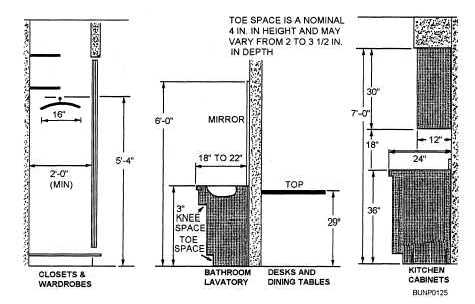as built-in unit. Floor plans usually show the cabinetwork location, while elevation plans usually provide detailed dimensions, as shown in figure 5-2.
DESIGNING A PRODUCT
Builders are often provided with complete working drawings of a product to be constructed. The drawings usually contain information to build the product, such as size, style, material, construction, and finish. Sometimes the Builder must design, sketch, and make a working drawing from the customer's verbal specifications or from simple line drawings. To make a working drawing from the incomplete instructions supplied by the customer, the Builder must
1. know the principles of good cabinet design;
2. be familiar with popular cabinet styles;
3. develop a sketch that meets the customer's specifications and conforms to good design principles;
4. make a working drawing from the sketch in order to build the product.
When designing a product, you must consider the purpose, strength, size-shape proportion, appearance, time, and cost of the product. The time designing helps avoid mistakes and saves time in the long run. One of the most important considerations in designing a product is its purpose. A product's purpose maybe the deciding factor in determining the design. For example, a bookcase must be the proper size and strength to hold the desired quantity and kind of books. Cabinets and furniture are usually make only strong enough to fulfill their purpose. The strength required of a object may determine such things as the type of joint, the size, and the kind of wood. It is often better to use strong woods like oak, ash, or maple to give the strength required by a product. Oversized softwood, like pine, may also be used. However, using oversize parts gives a massive and awkward appearance to a product.
Some furniture and cabinets must be built to standard sizes in order to serve its purpose. A dining table that is too low will not serve its purpose. A kitchen cabinet counter top that is too narrow will not accommodate a sink. In addition to size and shape, the designer must also consider proportion. The proportion of a cabinet is the relationship between its dimensions which include its width, height, and length. Some proportions are more pleasing to the eye than others.
The appearance of a cabinet maybe largely due to its purpose, location, and finish. If the product is to be painted, a less expensive material maybe used. If it is stained with a clear finish, a better quality material should be used. The appearance of cabinet doors may be changed by cutting shapes in doors instead of solid doors. The edges of the doors may be lipped or cut square according to the appearance desired.

Figure 5-2. - Typical dimensions for cabinetwork.
Continue Reading